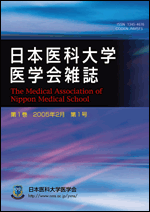Volume 21, Issue 2
Displaying 1-22 of 22 articles from this issue
- |<
- <
- 1
- >
- >|
-
2025Volume 21Issue 2 Pages 44
Published: April 20, 2025
Released on J-STAGE: May 21, 2025
Download PDF (175K) -
2025Volume 21Issue 2 Pages 45-49
Published: April 20, 2025
Released on J-STAGE: May 21, 2025
Download PDF (802K) -
2025Volume 21Issue 2 Pages 50-55
Published: April 20, 2025
Released on J-STAGE: May 21, 2025
Download PDF (459K) -
2025Volume 21Issue 2 Pages 56-60
Published: April 20, 2025
Released on J-STAGE: May 21, 2025
Download PDF (1093K) -
2025Volume 21Issue 2 Pages 61-66
Published: April 20, 2025
Released on J-STAGE: May 21, 2025
Download PDF (1377K) -
2025Volume 21Issue 2 Pages 67-72
Published: April 20, 2025
Released on J-STAGE: May 21, 2025
Download PDF (1667K) -
2025Volume 21Issue 2 Pages 73-79
Published: April 20, 2025
Released on J-STAGE: May 21, 2025
Download PDF (1396K) -
2025Volume 21Issue 2 Pages 80-97
Published: April 20, 2025
Released on J-STAGE: May 21, 2025
Download PDF (6092K) -
2025Volume 21Issue 2 Pages 98-105
Published: April 20, 2025
Released on J-STAGE: May 21, 2025
Download PDF (2772K)
-
2025Volume 21Issue 2 Pages 105-114
Published: April 20, 2025
Released on J-STAGE: May 21, 2025
Download PDF (464K) -
2025Volume 21Issue 2 Pages 115-124
Published: April 20, 2025
Released on J-STAGE: May 21, 2025
Download PDF (512K) -
2025Volume 21Issue 2 Pages 125-132
Published: April 20, 2025
Released on J-STAGE: May 21, 2025
Download PDF (387K) -
2025Volume 21Issue 2 Pages 133-141
Published: April 20, 2025
Released on J-STAGE: May 21, 2025
Download PDF (420K) -
2025Volume 21Issue 2 Pages 142-150
Published: April 20, 2025
Released on J-STAGE: May 21, 2025
Download PDF (392K) -
2025Volume 21Issue 2 Pages 151-159
Published: April 20, 2025
Released on J-STAGE: May 21, 2025
Download PDF (460K) -
2025Volume 21Issue 2 Pages 160-167
Published: April 20, 2025
Released on J-STAGE: May 21, 2025
Download PDF (395K)
Photogravure
-
2025Volume 21Issue 2 Pages 168-169
Published: April 20, 2025
Released on J-STAGE: May 21, 2025
Download PDF (403K)
Article
-
2025Volume 21Issue 2 Pages 170-174
Published: April 20, 2025
Released on J-STAGE: May 21, 2025
Download PDF (323K)
Case Reports
-
2025Volume 21Issue 2 Pages 175-180
Published: April 20, 2025
Released on J-STAGE: May 21, 2025
Download PDF (1139K) -
2025Volume 21Issue 2 Pages 181-185
Published: April 20, 2025
Released on J-STAGE: May 21, 2025
Download PDF (368K)
Talking Point
-
2025Volume 21Issue 2 Pages 186-187
Published: April 20, 2025
Released on J-STAGE: May 21, 2025
Download PDF (216K)
-
2025Volume 21Issue 2 Pages 188-190
Published: April 20, 2025
Released on J-STAGE: May 21, 2025
Download PDF (208K)
- |<
- <
- 1
- >
- >|
